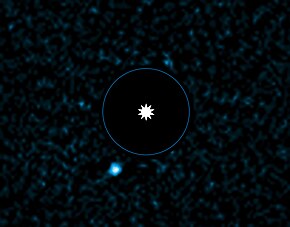 VLT image of the star HD 95086 and its planetary companion, seen here as a blue smudge. | |
| Discovery[1] | |
|---|---|
| Discovered by | Rameau et al. |
| Discovery site | Very Large Telescope |
| Discovery date | 2013 |
| Direct imaging | |
| Designations | |
| Levantes[2] | |
| Orbital characteristics | |
| 51-73 AU[3] | |
| Eccentricity | ≤ 0.18[3] |
| Inclination | 144+18 −4°[3] |
| 2004+105 −45 d[3] | |
| Star | HD 95086 |
| Physical characteristics | |
| Mass | 5.0 ± 2.0 MJ |
| 3.85 ± 0.5 m/s2 (12.6 ± 1.6 ft/s2) | |
Spectral type | L7–L9[4] |
HD 95086 b, formally named Levantes,[2] is a confirmed,[5] directly imaged exoplanet orbiting the young, 17 Myr[6] A-class pre-main-sequence star HD 95086. It is roughly 5 times as massive as Jupiter and orbits about 70 AU away from the parent star. It was detected at thermal infrared wavelengths (3.8 μm) through direct imaging, using the NACO instrument on the VLT.[1] A debris disk has been detected in this system at submillimeter wavelengths and has been resolved in the far-infrared from data obtained with the Herschel Space Observatory.[7]
The host star was considered a highly probable member of the Lower Centaurus Crux star forming region,[8] until tentatively reassigned with 71% probability to the Carina association.[9] The star has a mass of 1.6 solar masses making it a late A type star. It is located approximately 90 parsecs away in the constellation of Carina.[10]
- ^ a b Cite error: The named reference
Rameau2013awas invoked but never defined (see the help page). - ^ a b Cite error: The named reference
NEW2022was invoked but never defined (see the help page). - ^ a b c d Cite error: The named reference
Desgrangewas invoked but never defined (see the help page). - ^ Cite error: The named reference
Ghauvin2018was invoked but never defined (see the help page). - ^ Cite error: The named reference
Rameau2013bwas invoked but never defined (see the help page). - ^ Eric E. Mamajek. "Post-T Tauri Stars in the Nearest OB Association". Retrieved 2002-05-20.
- ^ Cite error: The named reference
Moor2013was invoked but never defined (see the help page). - ^ P. T. De Zeeuw (1998-09-14). "A Hipparcos census of the nearby OB associations".
- ^ Booth, Mark; Del Burgo, Carlos; Hambaryan, Valeri V. (2021). "The age of the carina young association and potential membership of HD 95086". Monthly Notices of the Royal Astronomical Society. 500 (4): 5552–5560. arXiv:2011.07083. doi:10.1093/mnras/staa3631.
- ^ F. van Leeuwen. "Validation of the new Hipparcos reduction". Archived from the original on 2013-11-01. Retrieved 2007-08-08.